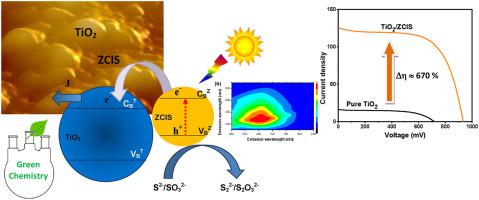Optical Materials ( IF 3.9 ) Pub Date : 2021-09-08 , DOI: 10.1016/j.optmat.2021.111557 Josué C. Amaral-Júnior , Alexandra A.P. Mansur , Isadora C. Carvalho , Herman S. Mansur

|
Colloidal semiconductor quantum dots (QDs) have been intensively investigated because of their remarkable tunable optical and electrical properties for potential clean energy production through solar photoconversion devices. Herein, we present for the first time the design and development of a hybrid nanostructure for applications in sunlight energy photoconversion, relying on a “safe and sustainable by design (SSD)” strategy, as follows: a) “Cadmium-free” (non-Cd-containing) inorganic semiconductor quantum dots (QDs), as optically active nanomaterials composed of quaternary Cu–In–S/ZnS systems (ZCIS); b) carboxylic-functionalized cellulose derivative (CMC) as biopolymer ligand and macromolecular stabilizing agent; c) A green chemistry approach based on an aqueous synthesis at mild conditions (e.g., pH, temperature, “organic-free”, nontoxic precursors) for creating water-soluble supramolecular colloidal core-shell nanostructures (i.e., ZCIS@CMC, core: ZCIS; shell: CMC); d) As a proof-of-concept, the fabrication of a photoelectrochemical cell (PEC-cell) based on a solid-liquid heterojunction using the photoanode composed of TiO2 sensitized by ZCIS@CMC nanohybrids. Regarding optical properties, the results demonstrated that the ZCIS@CMC nanohybrids presented absorption/emission characteristics with maxima responses within the visible range of the light spectrum, which is prospectively appropriate for sunlight photoconversion applications. The solid-liquid junction photoelectrochemical cells (PEC-cell) fabricated using TiO2 films deposited onto ITO glass slides sensitized by ZCIS QDs evidenced photoactivity under visible light illumination using “dark” (“OFF”) and “light” (“ON”) cycles. Moreover, the PEC-cells confirmed the significant enhancement of photoinduced current density (over 150%) upon illumination when the relative sensitization density associated with the ZCIS QDs/TiO2 ratio was increased, and ethanol was used as the co-solvent. The results were credited to better contact between ZCIS QDs and TiO2 nanoparticles, tailoring a more favorable energy level alignment at the heterojunction interfaces, promoting the formation of a cascade of conduction band edges. Thus, these quantum dot-sensitized nanostructures developed through a sustainable and biocompatible approach produced strictly via green chemistry process can be anticipated as a sustainable alternative to the existing heavy metal-based sunlight photoactive optical nanomaterials after further optimization of conversion efficiency parameters.
中文翻译:

用于太阳光能量收集的光学光敏 Cu-In-S@ZnS 核壳量子点/生物聚合物敏化 TiO2 纳米结构
胶体半导体量子点 (QD) 因其显着的可调谐光学和电学特性而被广泛研究,可通过太阳能光电转换装置生产潜在的清洁能源。在此,我们首次提出了基于“安全和可持续设计(SSD)”策略的用于太阳能光转换应用的混合纳米结构的设计和开发,如下:a)“无镉”(非-含镉)无机半导体量子点(QD),作为由四元 Cu-In-S/ZnS 系统(ZCIS)组成的光学活性纳米材料;b) 羧基官能化纤维素衍生物 (CMC) 作为生物聚合物配体和大分子稳定剂;c)绿色基于在温和条件下(例如, pH、温度、“无有机物”、无毒前体)的水性合成的化学方法,用于创建水溶性超分子胶体核壳纳米结构(即ZCIS@CMC,核:ZCIS;壳: CMC); d) 作为概念验证,使用由 TiO 2组成的光阳极制造基于固液异质结的光电化学电池(PEC 电池)由 ZCIS@CMC 纳米杂化物敏化。关于光学特性,结果表明 ZCIS@CMC 纳米杂化物在光谱的可见光范围内具有最大响应的吸收/发射特性,这有望适用于太阳光光电转换应用。使用沉积在由 ZCIS QD 敏化的 ITO 载玻片上的TiO 2薄膜制造的固液结光电化学电池(PEC 电池)在可见光照射下使用“暗”(“关”)和“光”(“开”)证明了光活性循环。此外,当与 ZCIS QDs/TiO 2相关的相对敏化密度增加时,PEC 电池证实了光照后光生电流密度的显着增强(超过 150%)增加比例,并使用乙醇作为共溶剂。结果被认为是 ZCIS QD 和 TiO 2纳米粒子之间更好的接触,在异质结界面处定制了更有利的能级排列,促进了导带边缘级联的形成。因此,在进一步优化转换效率参数后,通过严格通过绿色化学工艺生产的可持续和生物相容性方法开发的这些量子点敏化纳米结构有望成为现有重金属基太阳光光敏光学纳米材料的可持续替代品。


























 京公网安备 11010802027423号
京公网安备 11010802027423号